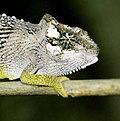Bradypodion
| Bradypodion | |
|---|---|

| |
| Robertson dwarf chameleon (Bradypodion gutturale) at Anysberg Nature Reserve | |
| Scientific classification | |
| Domain: | Eukaryota |
| Kingdom: | Animalia |
| Phylum: | Chordata |
| Class: | Reptilia |
| Order: | Squamata |
| Suborder: | Iguania |
| Family: | Chamaeleonidae |
| Subfamily: | Chamaeleoninae |
| Genus: | Bradypodion Fitzinger, 1843 |
| Type species | |
| Chamaeleo pumilus Daudin, 1802
| |
| Diversity | |
| 20 species | |
Bradypodion (meaning "slow-footed" in
Bradypodion feed on small invertebrates, especially insects.[1] They rapidly reach sexual maturity, typically at an age between half a year and one year, but sometimes up to two years.[1][2] Adult males are territorial.[1] It is the only genus of chameleon where females of all species give birth to live young rather than lay eggs (the only other chameleons that give birth to live young are certain Trioceros species). This is likely an adaption to the relatively cold climate of southern Africa in comparison to tropical Africa. Colder temperatures slow the development of eggs laid in the ground; when instead retained inside the body until birth, a female can actively sun bask to increase the temperature.[3] A female can give birth to up to 20 young per time, twice or rarely even three times in a year.[1]
Up until the early 2000s, some other chameleons from eastern and central Africa were occasionally placed herein, but they are now placed in Kinyongia and Nadzikambia.[4]
Species
20 species are currently recognized:
| Image | Common Name | Scientific name | Distribution |
|---|---|---|---|
 |
Swartberg dwarf chameleon | B. atromontanum | Western Cape, South Africa |
| B. barbatulum | South Africa | ||
| B.baviaanense | South Africa | ||
 |
uMlalazi dwarf chameleon |
B. caeruleogula | KwaZulu-Natal, South Africa. |
 |
Transkei dwarf chameleon | B. caffrum | Eastern Cape Province of South Africa |
 |
Knysna dwarf chameleon | B. damaranum | Knysna, South Africa |
 |
Drakensberg dwarf chameleon | B. dracomontanum | Drakensberg, South Africa |
 |
Robertson dwarf chameleon | B. gutturale (may be several species) | Western Cape province, South Africa. |
 |
Kentani dwarf chameleon | B. kentanicum | Eastern Cape, South Africa. |
 |
Black-headed dwarf chameleon | B. melanocephalum | KwaZulu-Natal, South Africa. |
 |
Zululand dwarf chameleon | B. nemorale (probably several species) | South Africa. |
| Ngome dwarf chameleon | B. ngomeense | Ngome Forest, Kwa-Zulu Natal. | |
 |
Namaqua dwarf chameleon | B. occidentale | South Africa and Namibia. |
 |
Cape dwarf chameleon | B. pumilum | South African province of the Western Cape |
 |
Setaro's dwarf chameleon | B. setaroi | northern Kwazulu Natal, South Africa |
 |
Smith's dwarf chameleon | B. taeniabronchum | South Africa |
 |
Natal Midlands dwarf chameleon | B. thamnobates | South African province of KwaZulu-Natal. |
 |
Transvaal dwarf chameleon | B. transvaalense | Mpumalanga and Limpopo provinces, South Africa |
 |
Southern dwarf chameleon |
B. ventrale | Eastern Cape, South Africa. |
| B. venustum | South Africa |
Undescribed species

- Emerald dwarf chameleon, Bradypodion sp. (Emerald)
- Bradypodion sp. (Groendal)
- Bradypodion sp. (Grootvadersbosch)
- Bradypodion sp. (Jagersbos)
Systematics
Delimitation of Bradypodion has been controversial for some time. Most species seem readily distinguishable by
The
The remaining species form a well-supported
Another group of taxa occurs from easternmost Eastern Cape to central
Several largish but short-tailed and
The remaining species are all small inhabitants of forested slopes and fynbos, such as the black-headed and Smith's dwarf chameleons. However, as already indicated by the distinctness of these two, their morphologies seem to be a
In conclusion, of the three basic morphotypes found in this genus, one (bright, long-tailed, large) is plesiomorphic, another (large, short-tailed, drab) apparently only evolved once, and the third (the small, slope-inhabiting forms) are convergent in morphology. The ancestors of Bradypodion thus were mid-sized chameleons with vivid color, which settled the Cape region from roughly north-northwestwards. Due to
Footnotes
- ^ ISBN 1-86872-040-3.
- ^ "Ep 21: South African Dwarf Chameleons". ChameleonAcademy. 15 April 2023. Retrieved 31 October 2023.
- .
- .
- ^ Klaver & Böhme (1986), Branch (1998)
- ^ Klaver & Böhme (1997)
- ^ Branch (1998), Tolley et al. (2004)
- ^ Raw (2001)
- ^ a b c d e f Tolley et al. (2004)
- ^ Branch (1998): plate 1, Tolley et al. (2004)
- ^ Raw (2001), Tolley et al. (2004)
References
- Branch, W.R. (1998): Field Guide to Snakes and Other Reptiles of Southern Africa. Struik Publishers Ltd, Cape Town (revised edition).
- Klaver, C.J.J. & Böhme, W. (1986): Phylogeny and classification of the Chamaeleonidae (Sauria) with special reference to hemipenis morphology. Bonner Zoologische Monographien 22: 1–64.
- Klaver, C.J.J. & Böhme, W. (1997): Liste der rezenten Amphibien und Reptilien - Chamaeleonidae. Das Tierreich 112: i-xiv, 1-85.
- Tolley, Krystal A.; Tilbury, Colin R.; Branch, William R. & Matthee, Conrad A. (2004): Phylogenetics of the southern African dwarf chameleons, Bradypodion (Squamata: Chamaeleonidae). Molecular Phylogenetics and Evolution 30: 354–365.
